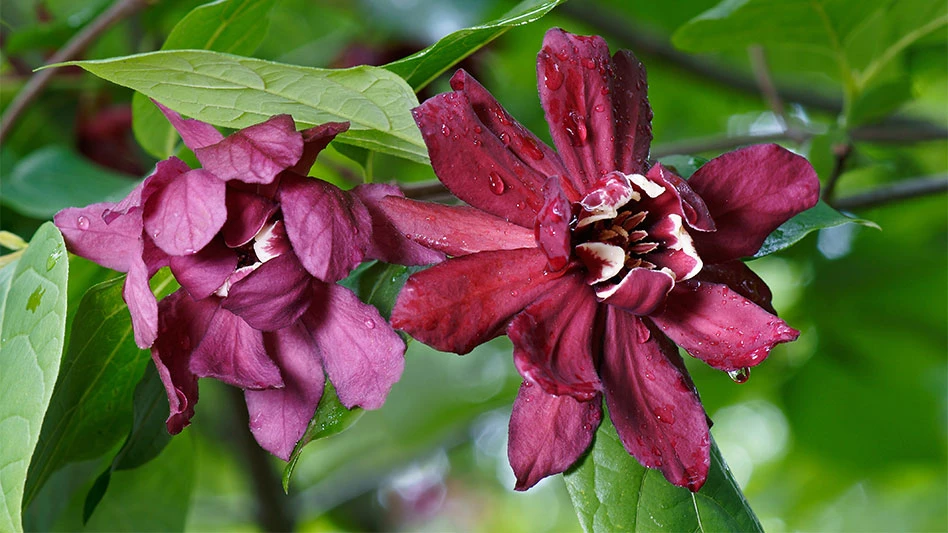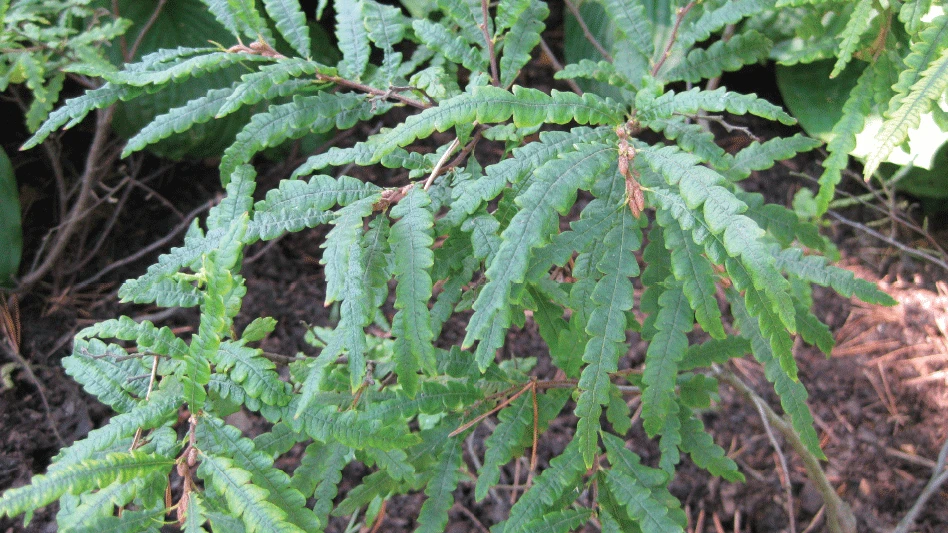 John D. Rockefeller once said, "Don't be afraid to give up the good to go for the great." A father and son research team is studying the concept of precision application technology, a revolutionary approach to traditional nursery growing techniques, designed to take plants from good to great.
John D. Rockefeller once said, "Don't be afraid to give up the good to go for the great." A father and son research team is studying the concept of precision application technology, a revolutionary approach to traditional nursery growing techniques, designed to take plants from good to great.
William "Bill" Bauerle Sr., professor emeritus at The Ohio State University, and his son Bill Bauerle Jr. of Colorado State University, have been creating a form of "precision agriculture" for the nursery industry. In general, this system approach looks at the needs of the individual plants on a continuous basis during the growing season and a delivery system to precisely apply only the amount of water and nutrients the plant needs. Once data is analyzed, the correct nutrients and water are applied to maximize the growth and desired outcome of the plants. This technology puts the grower in control of what happens to the plants throughout the growing season, without having to rely only on controlled-release fertilizers, which are dependent on soil moisture and temperature.
The Bauerles are in the second year of a multiyear test at Willoway Nurseries in Avon, Ohio. To date, the research has shown a 30 percent growth increase in the first year while the second year brings exponential growth to plants. They are finding lateral secondary branching two to four times more on primary lateral branches.
A nursery evolution
Tom explains that Willoway started this process at the concept level; "we didn't know what we didn't know." Tom said his crew has always done pH control and used acid to adjust pH levels, but that it was nowhere in the same league as what they are doing now with Bauerle's methods. Quoting entrepreneur Debbie Fields of Mrs. Fields Cookies fame, "Good enough never is," and Tom isn't content with waiting for the government to fund plant research. He feels that other industries are driving their own research and so why shouldn't the nursery industry?
So Tom is literally putting his money where his mouth is by collaborating with the Bauerles and hoping that it ultimately pays off in green dividends. There is no government funding for this research project at Willoway Nurseries, so the company is bearing the financial burden itself.
Why go out on a limb with product, time and money, especially during these difficult economic times? Willoway wants to offer its customers a value proposition beyond branding. Tom feels that the next logical way to differentiate his company from competitors is to create the "perfect" designer plant for the end consumer. Tom says that precision nutrient application is a revolutionary approach to traditional ornamental growing techniques. He firmly believes it is one of the next steps in the evolution of the nursery industry; improvement in growing processes to elevate plant quality.
From Greenhouse Bench to Nursery Row Bill Bauerle Sr. was in research production and extension at The Ohio State University specializing in stress physiology, substrates and hydroponics production. Specifically he worked with greenhouse growers on plant nutrition. He formally retired in 1992. Since then he has continued to work on adapting his nutrition recipes used for growing uniform greenhouse vegetables and floriculture crops and adapting it to ornamental nursery production to achieve the same predictable crop results. With his professor emeritus status at the university, he pursued his research at the Ohio Agricultural Research and Development Center (OARDC) in Wooster, Ohio. Bill Bauerle Sr. was in research production and extension at The Ohio State University specializing in stress physiology, substrates and hydroponics production. Specifically he worked with greenhouse growers on plant nutrition. He formally retired in 1992. Since then he has continued to work on adapting his nutrition recipes used for growing uniform greenhouse vegetables and floriculture crops and adapting it to ornamental nursery production to achieve the same predictable crop results. With his professor emeritus status at the university, he pursued his research at the Ohio Agricultural Research and Development Center (OARDC) in Wooster, Ohio. |
The analysis procedure
The nutrient application experiment at Willoway has 400 trees in the test area with 16 different test scenarios with four reps of each. They are comparing trees potted in pine bark mix with incorporated and top-dress slow release fertilizers plants that are irrigated with recycled water infused with individual nutrients with the control trees irrigated with plain city water and no added nutrients. They regularly collect and perform analysis from leachate. Based on the analytical results and based on the plants' physiological activity, specific individual nutrients (N, P, K and others) are applied to achieve and maintain superior plant development and quality while minimizing inputs and reducing growing time.
 Bill Bauerle Sr. (left) and Tom Demaline of Willoway Nurseries (right) compare Cercis canadensis seedlings. The one on the left was treated with precision application nutrient water with pH control while the one on the right was not. Bill Bauerle Sr. (left) and Tom Demaline of Willoway Nurseries (right) compare Cercis canadensis seedlings. The one on the left was treated with precision application nutrient water with pH control while the one on the right was not. |
A good analogy of this plant nutrition system is to compare it to preventive medicine for humans. If people don't eat right they get sick. One of the ways to determine what is wrong when you are sick is to take a urine sample. Doctors analyze what is not being used (proteins, for example). Consider metabolism being akin to the Law of the Minimum for plants.
Additionally, they are looking at changing the type of nitrogen source. The chemical conversion of urea, a commonly used field fertilizer, produces intermediate toxic products such as ammonia (NH3) and nitrites (NO2−)which result in root injury and death when absorbed by the plant through the irrigation water.
Sharing the research
Last fall, Willoway hosted a seminar for other nurseries to learn about the precision application technology. Attendee Dave Van Essen, owner of Van Essen Nursery Co. in Lebanon, Ore., sees the importance of spending money on both research and on fertilizer.
"How much fertilizer does a plant really need," Van Essen asked. "pH is critical because when it is off, no amount of fertilizer won't really matter or make a difference. The concept basically revolves around the fact that a plant will only do as well as the lowest common available nutrient."
Eric Nordlie, production manager of plant health at Bailey Nurseries in St. Paul, Minn., wants to improve efficiency at the nursery.
"I was intrigued with the concept of being more precise in our utilization of both nutrients and water in growing our product," Nordlie said. "I feel we are quite inefficient in our use of both of these resources and see both of them as becoming problems as far as environmental impact at some point in the future. We are trying to dial down our fertilizer and water usage, but what we're doing is preistoric compared to what Tom and Bill are looking at."
Nordlie said he was impressed with the flexibility of this type of system, but he did have some concerns on the infrastructure costs.
 The Controlled Nutrient Delivery System was designed and built by Bill Bauerle Sr. It has the ability to inject 16 major and minor single element nutrient fertilizers into the water for precise application when and where the plants need them. The Controlled Nutrient Delivery System was designed and built by Bill Bauerle Sr. It has the ability to inject 16 major and minor single element nutrient fertilizers into the water for precise application when and where the plants need them. |
And while Nordlie hasn't changed Bailey's system or implemented things learned at the seminar, it got him thinking about the role of minors as well as the nursery's high usage of coated urea and what implications that may have on plant growth compared to nitrate-based products. The big question in his mind is whether this type of a system will allow nurseries to produce plants more quickly, at a lower cost and in an environmentally responsible manner.
Nordlie's concerns mirror what Bauerle Sr. feels is the key ingredient to his precision application technology system.
"We can recirculate all of the storm water on a farm. Capture it, store it, clean it and use it again," Bauerle Sr. said. "This process does not put further demands on our groundwater resources nor does it cause environmental pollution. It is truly a sustainable alternative."
For more: Bill Bauerle Sr., billbauerle2003@yahoo.com. Willoway Nurseries, (440) 934-4435; www.willowaynurseries.com.
WANT MORE?
Enter your email to receive our newsletters.

Explore the January 2012 Issue
Check out more from this issue and find your next story to read.
Latest from Nursery Management
- How impending tariffs and USDA layoffs impact the horticulture industry
- Shifting the urban environment
- These companies are utilizing plastic alternatives to reduce horticultural waste
- How to create a sustainable plant nursery
- Lamiastrum galeobdolon ‘Herman’s Pride’
- One of rarest plants on earth: Tahina spectabilis
- Leading Women of Horticulture: Angela Labrum, Bailey Nurseries
- Get to know Pat Reilly with NewGen Boxwood and the American Boxwood Society





